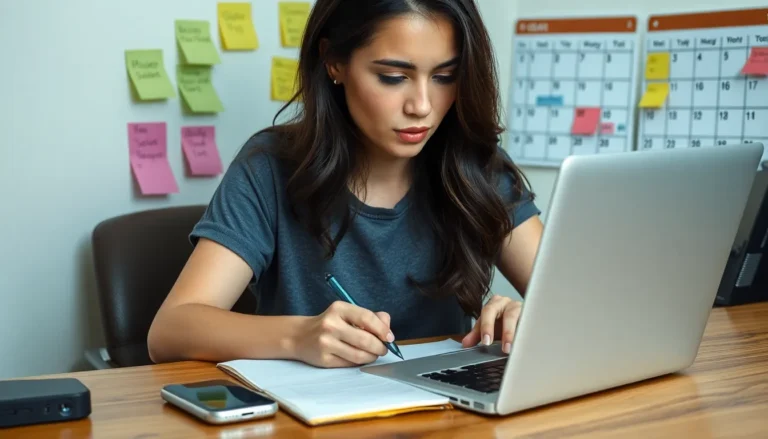In a world where mobile devices reign supreme, sometimes it feels like browsing the web on an iPhone is like trying to fit a giraffe in a phone booth. But fear not! With desktop mode, users can transform their tiny screens into a full-fledged browsing experience. No more squinting at tiny text or playing the guessing game with mobile layouts.
Table of Contents
ToggleUnderstanding Desktop Mode on iPhone
Desktop mode on an iPhone allows users to view websites as if they were using a computer. This feature enhances browsing by providing a familiar interface with ample content.
What Is Desktop Mode?
Desktop mode displays a full desktop version of a website instead of the mobile version. Users access desktop mode by selecting the option within their browser settings. Browsers like Safari and Chrome offer this feature, presenting users with comprehensive navigation and layout typically seen on larger screens.
Benefits of Using Desktop Mode
Using desktop mode offers several advantages. Enhanced visibility allows users to read content easily without zooming. Accessing more features improves usability, as desktop sites often provide additional options not available in mobile versions. Compatibility with complex websites expands usability for tasks like online shopping or banking. Overall, desktop mode transforms the iPhone browsing experience into a more user-friendly interaction.
How to Enable Desktop Mode
Enabling desktop mode on an iPhone allows users to access websites in their full versions. This feature can enhance the overall browsing experience.
Using Safari Browser
Open Safari on the iPhone to begin. Tap the ‘aA’ icon located in the upper-left corner. Select ‘Request Desktop Website’ from the dropdown menu. Websites will now refresh and display the desktop version, providing more content and easier navigation. Frequent users can set Safari to always request the desktop version for specific sites by going to Settings, then Safari, and selecting the ‘Request Desktop Website’ option.
Accessing Desktop Mode in Other Browsers
Using Chrome on an iPhone also enables desktop mode. Start by launching the Chrome app. Tap the three-dot menu in the lower-right corner. Choose ‘Request Desktop Site’ from the options provided. This action will refresh the page, allowing access to the full desktop version. Users of other browsers may find similar options, often under menu settings, allowing for easy switching to desktop mode as needed.
Common Issues and Troubleshooting
Browsing in desktop mode can present challenges. Users might encounter problems while loading desktop sites or face compatibility issues.
Problems with Loading Desktop Sites
Slow loading times frequently occur when using desktop mode. Heavy elements from a full site can hinder performance. Sometimes, server issues may also contribute to the delay. If an iPhone struggles with internet connectivity, this can further complicate access to certain sites. It’s important to ensure a stable connection when accessing complex websites in desktop mode. Clearing the browser cache might help too, as a cluttered cache can create loading problems. Users experiencing these issues may find switching back to mobile mode temporarily beneficial for smoother browsing.
Resolving Compatibility Issues
Compatibility issues often arise with certain websites in desktop mode. Not all sites are optimized for mobile devices, causing layout problems and broken links. Some sites may not support specific features essential for user interaction, like pop-ups or multimedia elements. When compatibility problems occur, switching back to mobile site view may resolve the issue. Additionally, ensuring that the browser is updated can improve overall compatibility with various websites. Users might also consider trying different browsers as they can vary in handling desktop sites. Effective troubleshooting often involves experimenting to find the best settings for individual browsing needs.
Tips for Optimal Use of Desktop Mode
Accessing desktop mode on an iPhone enhances browsing for those who prefer a computer-like interface. Users can maximize their experience by following some practical tips.
Best Practices for Navigation
Utilizing intuitive gestures simplifies navigation through desktop mode. Users can scroll with finger swipes or tap to click on links. Tap and hold for options like opening links in new tabs. Avoid excessive zooming, as it can lead to misaligned text and images. Frequently check the address bar for site-specific actions, such as signing in or accessing menus. Familiarizing oneself with the layout replicates the desktop experience efficiently.
Enhancing Your Experience
Adjusting browser settings optimizes the desktop mode usage. Ensure JavaScript is enabled to access dynamic content without issues. Activate privacy settings to manage cookies effectively, which enhances loading times on sites. Using reader mode in Safari reduces clutter, focusing on text without distracting elements. Bookmark frequently visited sites for quicker access in the future. Experimenting with different browsers helps find the most compatible one for specific tasks. Each small adjustment contributes to a smoother, more efficient browsing experience on the iPhone.
Embracing desktop mode on an iPhone can significantly enhance the browsing experience. By accessing full desktop layouts users can enjoy clearer visibility and improved functionality. This feature is particularly beneficial for tasks that require detailed navigation like online shopping or banking.
With simple steps to enable desktop mode in popular browsers like Safari and Chrome users can easily switch to a more familiar interface. Troubleshooting tips and best practices ensure that any potential issues are managed effectively.
By optimizing their browsing settings users can transform their iPhone into a powerful tool for web exploration. Ultimately desktop mode provides a seamless way to navigate the complexities of the internet with ease.


